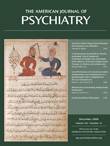Cost-Effectiveness of Second-Generation Antipsychotics and Perphenazine in a Randomized Trial of Treatment for Chronic Schizophrenia
Abstract
BACKGROUND: Second-generation antipsychotics have largely replaced first-generation antipsychotics for the treatment of schizophrenia, but a large-scale cost/effectiveness analysis has not been attempted. Method: Patients with schizophrenia (N=1,493) were assigned to treatment with a first-generation antipsychotic (perphenazine) or one of four second-generation drugs (olanzapine, quetia-pine, risperidone, or ziprasidone) and followed for up to 18 months. Patients with tardive dyskinesia were prohibited from assignment to perphenazine. Patients could be reassigned at any time to another second-generation drug, including clozapine, but not to perphenazine. The cost analysis included medications plus health services use. Quality-adjusted life year (QALY) ratings were assessed on the basis of Positive and Negative Syndrome Scale (PANSS) subscale scores and side effects. An intention-to-treat analysis included all available observations, classified by initial drug assignment, and costs of reassignment of most patients to another second-generation drug. The analysis was repeated considering only treatment on initially assigned medications. Results: Although QALY ratings, PANSS scores, and other quality of life measures indicated modest improvement over 18 months, there were no significant differences between perphenazine and any second-generation medication. Average total monthly health care costs were $300–$600 (20%–30%) lower for perphenazine than for second-generation antipsychotics because of lower drug cost. Differences in costs remained when maximally discounted drug prices were used for all patients and when only observations during treatment with the first medication were included. Conclusions: Treatment with perphenazine was less costly than treatment with second-generation antipsychotics with no significant differences in measures of effectiveness. However, the trial was limited by a high dropout rate, and longer-term neurological and metabolic side effects require further study.



